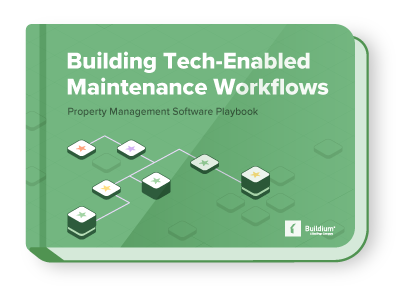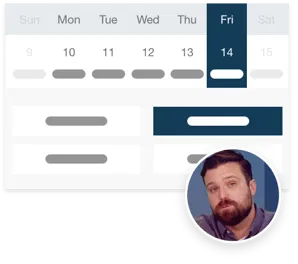Doing a thorough inspection is more than just checking for damage from time to time. It’s about keeping your properties fresh and up to date for incoming residents, making sure infrastructure and other repairs are done, and ensuring properties are clean, up to code, and compliant with local and state laws.
One of the most effective tools to make sure all this happens is a rental inspection checklist. We’ve put together some resources to help you better understand what a rental inspection—and a rental inspection checklist—includes and how you should be conducting one.
What Is a Rental Inspection Checklist?
A rental inspection checklist is a detailed document used during the move-in and move-out process, as well as during quarterly or yearly inspections. It serves as a record of the property’s condition. This checklist typically includes various aspects of the property, such as the condition of walls, floors, appliances, fixtures, and any other relevant features.
Why Is a Rental Inspection Checklist Important?
There are four main reasons why rental inspection checklists for move-in, move-out, and regular inspections are important:
- Prevents Disputes: One of the primary reasons for using a rental inspection checklist is to prevent disputes between landlords and tenants. By documenting the property’s condition at the start and end of the tenancy, both parties have a clear record to refer to if there are any disagreements about damages or repairs.
- Ensures Accountability: A rental inspection checklist holds both landlords and tenants accountable for the property’s condition. Tenants are responsible for maintaining the property and reporting any issues, while landlords are responsible for addressing necessary repairs and ensuring the property is habitable.
- Encourages Proper Maintenance: Regular inspections and the use of a checklist encourage tenants to take better care of the property. Knowing that the property’s condition is being monitored can motivate tenants to report issues promptly and avoid causing damage.
- Legal Compliance: In many jurisdictions, having a documented inspection process is a legal requirement. A rental inspection checklist can serve as evidence in court if there are any legal disputes regarding the property’s condition.
Rental Inspection Regulations
Many rental leases include a clause on when and how owners and property managers can enter a unit, and how much notice they are required to give. In fact, many states require that clause, and list the specific situations in which you can access a unit.
That usually includes inspecting the property and making repairs. When you create a lease, make sure to check your state’s regulations on inspections before including any wording in the lease itself.
Remember, for every inspection you should notify your resident that you’re coming. While your lease agreement may include language that allows you to enter their unit for inspections, repairs, or for a showing when the lease is up, you still shouldn’t go in without letting them know first.
According to legal help site NOLO, there are certain states that have no laws on when and for what reason you can enter a rental unit. Even so, you know how important it is to build a good relationship with your residents. Giving them a heads up that you’ll be entering their home, no matter the reason, will keep that relationship intact.
Move-In Inspection
Why Do You Need a Move-In Checklist?
According to NOLO, there are certain states that require you to present a written document on the condition of their apartment prior to move-in. To determine if your state is one of them, check with a legal professional.
If you do need to provide that document, it’s a good idea to start with a move-in checklist. Even for property managers who don’t live in one of these states, a move-in checklist provides a thorough report of the state of a unit at the time of move-in. It’s also a baseline you can use to gauge the condition of a unit when a resident moves out.
It gives your resident a record of the state of their new home, so they can address any immediate issues and feel confident they won’t be charged for anything they didn’t damage.
What Should Be on a Move-In Checklist?
A move-in checklist should include individual sections for all indoor and outdoor spaces that belong to the unit. Bedrooms, bathrooms, kitchens, outdoor patios, even front entryways should be accounted for. Each section should list specific features, furnishings, and appliances that are provided by the property owner.
If you need a template to get you started, check out our free, downloadable move-in checklist.
When and How Should You Do a Move-In Inspection?
A move-in inspection should be done as soon as a new resident moves in. Property managers should walk through the unit with residents to look for damage to anything on the list.
NOLO recommends writing down damage in detail. For instance, instead of writing “damaged fridge,” write “large dent on right-hand refrigerator door.”
Make sure to attach images or videos to each item on the list, as well. The bottom line is, the more thorough your inspection, the better you can repair all the damage needed, and the more confident your resident will feel about their new home.
Once you’ve finished the inspection, give a copy of the report to your resident, or share it through your resident portal.
Move-Out Inspection
Why Do You Need a Move-Out Checklist?
The flipside of a move-in inspection is the move-out inspection. The move-out inspection lets you catalog any damaged or worn parts of the unit that need repairing before the next resident moves in.
What Should Be on a Move-Out Checklist?
You should use the same checklist you used at move-in to do your move-out inspection. Go over all the same elements in all the same rooms and record the shape they’re in.
In some cases, you’re doing this to determine if there’s any serious damage the resident is responsible for. In other cases, you’re taking note of normal wear and tear that needs repairing before your next resident moves in.
That might include repainting slightly scuffed or faded walls, replacing older appliances, or ripping up worn carpet. These are things that are considered normal wear and tear, and are not the responsibility of the resident.
If there were large holes in the wall, broken appliances, or pet stains on the carpet, however, the resident moving out should pay for those. The difference is that normal wear and tear comes from everyday use, and would happen no matter who lived there.
Pro Tip: This is also a good time to take a look at HVAC filters for replacement and hood vents to give them a proper cleaning. And check smoke and carbon monoxide detectors, as well as extinguishers.
When and How Should You Do a Move-Out Inspection?
It’s best to have your resident present during a move-out inspection, right before their move-out date. Then you both can go over the checklist together once more.
Walk through the same checklist you used when they moved in. Write down any repairs you have to do in detail and note whether or not it’s considered normal wear and tear.
Take pictures and have the original pictures from the move-in inspection handy. Talk over each notation with your resident to come to an agreement on each of the repairs. Then, send them a copy of the inspection report.
If you’re doing a move-out inspection after they’re gone, make sure you send a copy of the checklist to them once you’ve completed it.
Quarterly or Seasonal Inspections
Why Do You Need Regular Inspections?
Regular inspections of your properties should go deeper than scuffed walls and broken bathroom tiles. First of all, they are likely a part of the contracted service that you provide to your owners to keep their properties in good shape and residents safe per your local regulations. Basically, you are looking under the hood to see that the infrastructure and systems of the unit are in good condition—so checking the status of systems like plumbing, heating, and electricity is important.
Of course, you’re checking these things during move-in and move-out as well, but it could be years until someone moves out of a unit. By that time, it may be too late for preventative maintenance.
You’re also inspecting the exterior and common areas of the building to look for larger issues.
Finally, they’ll help you prepare for the season to come. For winter, check pipes and outdoor spigots for proper insulation. Install storm windows. And make sure thermostats are working properly.
In spring, you can check for damage to roofs and outdoor facing from storms. You can go over those pipes again to look for cracks.
What Should Be On It?
A more thorough inspection of the property can look something like a home inspector’s checklist. For a free rental inspection template to get you started, click here.
When and How Should You Do a Seasonal or Quarterly Inspection?
Again, this is something you can schedule quarterly, at the transition of seasons, or at any other regular period of time that makes sense for your properties.
Go through your inspection list one item at a time. Start by walking around outside the property to check for issues. Then, move through entryways and common areas. Finally, walk through units.
Check off the things that are in good shape and make detailed notes of the things that need fixing. You can then send your report to the property owner so they have a clear understanding of the repair work that needs to happen.
Handling Multiple Inspections
Making sure you’re conducting thorough and consistent inspections on all your properties can be tricky. But there are tools that can help you keep it all organized.
If you don’t feel like printing off multiple inspection sheets, consider an app like HappyCo (a Buildium partner), which allows you to complete inspections with your phone or tablet using their templates or your own checklist.
It also syncs with Buildium, so your unit information is automatically loaded and inspections are saved to your account.
Inspections help keep your rental units safe, up-to-date, competitive, and comfortable for your residents. Most people think of them as simply a way to catalog damage done by residents, but they’re so much more than that. Think of them as a running inventory of your properties, keeping you on top of repairs and improvements, so you can build a strong reputation for reliability and trustworthiness with both residents and owners.
Common Rental Inspection Mistakes Property Managers Make
When conducting any kind of rental inspection, there are some pitfalls to avoid. We’ve listed some of the biggest ones here:
- Inadequate Documentation: Failing to document the condition of the property thoroughly can lead to disputes and misunderstandings. Always use a detailed checklist and take photos or videos to provide clear evidence of the property’s condition.
- Failing to Provide Adequate Notice: Conducting inspections without giving tenants proper notice can create tension and may violate local laws. Always provide sufficient notice and schedule inspections at a convenient time for tenants.
- Overlooking Small Issues: Ignoring minor issues can lead to bigger problems down the line. Address small repairs and maintenance tasks promptly to prevent them from escalating into costly repairs.
- Failing to Conduct Consistent Inspections: Inconsistent inspection practices can result in missed issues and unfair treatment of tenants. Establish a regular inspection schedule and follow the same procedures for every inspection.
- Failing to Communicate with Tenants and Owners: Failing to communicate effectively about the inspection process and findings can lead to misunderstandings and dissatisfaction. Be transparent, clear, and respectful in all communications.
- Neglecting to Follow Up: Conducting an inspection without following up on identified issues defeats the purpose of the inspection. Make sure that all necessary repairs and maintenance tasks are completed in a timely manner.
- Being Overly Critical: While it’s important to be thorough, being overly critical or nitpicky can strain the landlord-tenant relationship. Focus on significant issues that affect the property’s condition and tenant safety.
How Property Management Software Can Help with Rental Inspections
When it comes to rental inspections, property management software can boost efficiency, accuracy, and overall management of rental properties. Here are some key reasons why property management software is important in rental inspections:
- Streamlined Processes: Property management software automates and streamlines the inspection process. It allows property managers to schedule, conduct, and document inspections efficiently, reducing the time and effort required for manual processes.
- Accurate Documentation: The software provides a standardized format for recording inspection details, ensuring consistency and accuracy. Property managers can document the condition of the property easily, note any damages, and attach photos or videos for visual evidence. This helps maintain a comprehensive record of the property’s condition over time.
- Real-Time Updates: With property management software, inspection reports can be updated in real-time. This means that any issues identified during the inspection can be communicated to relevant parties, such as maintenance teams or property owners, for prompt resolution.
- Enhanced Communication: The software facilitates better communication between property managers, tenants, and property owners. Inspection reports can be shared digitally, allowing all parties to stay informed about the property’s condition and any necessary repairs or maintenance.
- Compliance and Legal Protection: Property management software helps ensure compliance with local regulations and standards. By maintaining detailed and accurate inspection records, property managers can protect themselves and property owners from potential legal disputes related to property condition and maintenance.
- Data Analysis and Reporting: The software allows property managers to analyze inspection data and generate reports. This can provide valuable insights into recurring issues, maintenance trends, and overall property performance, enabling better decision-making and proactive management.
To learn more about how property management software can help your team deliver a smooth turnover, check out Buildium. You can even sign up for a free 14-day trial to see for yourself.
Read more on Maintenance

